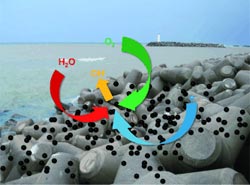Inspired by a Breakwater

<br>
Be it a battery or a fuel cell, efficient electrodes are the be-all and end-all of every electrochemical cell. In the journal Angewandte Chemie, a team of Korean and American scientists has now introduced a novel material for electrodes based on affordable melamine foam and carbon black.
The high porosity significantly facilitates fast mass transport and a high number of catalytically active centers drastically increase the oxygen-reducing activity of cathodes for fuel cells and metal-air batteries.
The reaction that occurs at the cathodes of fuel cells and metal-air batteries is the electrochemical reduction of oxygen, namely the oxygen reduction reaction (ORR). This reaction is considerably inhibited because of its sluggish rate, and the efficiency of the cells is lower than it could be. The catalytic cathode must ensure that oxygen reacts with water, taking up electrons to form OH- ions in alkaline solution. The problem is that in a complex system involving solid, liquid, and gaseous reactants, transport processes are often too slow and inhibit the process, especially when discharging with higher current densities.
Cathodes made of a porous carbon support (carbon black) on which a catalytically active metal like platinum is finely dispersed can very effectively minimize this kinetic inhibition. However, they are expensive and not very stable, thus making them impractical for widespread application. A team led by Jaephil Cho at the Ulsan National Institute of Science and Technology (Korea) and Meilin Liu at the Georgia Institute of Technology (USA) thus aimed to develop a more economical alternative.
They were inspired by the tetrapod structure (Greek tetra: four, podes: feet) of breakwaters to synthesize a new highly efficient electrocatalyst. Tetrapods, whose four “feet” are pointed toward the corners of an imaginary tetrahedron, are constructed at the coast as well as near dams and piers to reduce the force of waves crashing against the shore. These structures also provide sanctuary for marine life forms in their many large cavities. When melamine foam is pyrolyzed and ground with a mortar and pestle, it forms microscopic fragments resembling tetrapods.
The scientists treated melamine foam with iron chloride and nitrogen-doped ketjenblack (conducting pellets of carbon black). They carbonized this product and extracted it with sulfuric acid. The resulting nanotetrapods studded with nanoparticles of carbon black have a very high specific surface area, a large number of catalytically active centers (Fe/Fe3C, and CN groups), and many pores that allow for rapid mass transport. Cathodes made of this new electrode material are highly durable and excellent performance, comparable to those of metal-based cathodes – at a much lower price. These may represent a highly promising starting point for a new generation of inexpensive and highly efficient metal-air batteries and fuel cells.
About the Author
Jaephil Cho is Professor and Dean at the Interdisciplinary School of Green Energy at UNIST (South Korea). He is Director of the Converging Research Center for Innovative Battery Technologies and of the IT Research Center (both supported by the Korean government). His current research is focused mainly on metal–air batteries and nanostructured electroactive materials for lithium-ion batteries.
Author: Jaephil Cho, Ulsan National Institute of Science and Technology (Rep. Korea), http://jpcho.com/
Title: A Highly Efficient Electrocatalyst for the Oxygen Reduction Reaction: N-Doped Ketjenblack Incorporated into Fe/Fe3C-Functionalized Melamine Foam
Angewandte Chemie International Edition, Permalink to the article: http://dx.doi.org/10.1002/anie.201207193
Media Contact
More Information:
http://pressroom.angewandte.orgAll latest news from the category: Life Sciences and Chemistry
Articles and reports from the Life Sciences and chemistry area deal with applied and basic research into modern biology, chemistry and human medicine.
Valuable information can be found on a range of life sciences fields including bacteriology, biochemistry, bionics, bioinformatics, biophysics, biotechnology, genetics, geobotany, human biology, marine biology, microbiology, molecular biology, cellular biology, zoology, bioinorganic chemistry, microchemistry and environmental chemistry.
Newest articles

Bringing bio-inspired robots to life
Nebraska researcher Eric Markvicka gets NSF CAREER Award to pursue manufacture of novel materials for soft robotics and stretchable electronics. Engineers are increasingly eager to develop robots that mimic the…

Bella moths use poison to attract mates
Scientists are closer to finding out how. Pyrrolizidine alkaloids are as bitter and toxic as they are hard to pronounce. They’re produced by several different types of plants and are…

AI tool creates ‘synthetic’ images of cells
…for enhanced microscopy analysis. Observing individual cells through microscopes can reveal a range of important cell biological phenomena that frequently play a role in human diseases, but the process of…





















